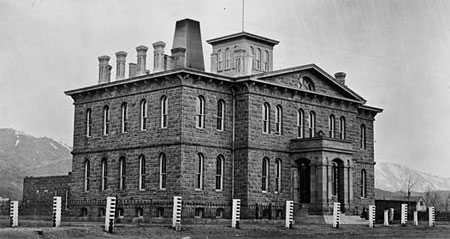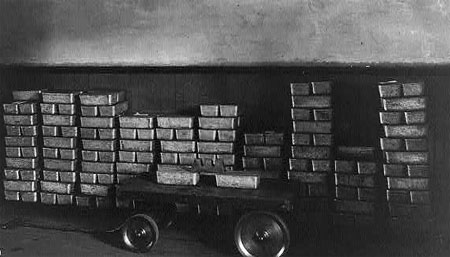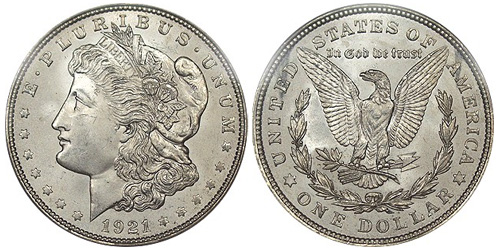Throughout the 30+ years of production of the Morgan Silver Dollars, there were three acts of Congress which had a significant impact on the series. The first can be seen as the birth certificate of the series, the second its continuation, and in some ways the third as its termination, or at least the destruction of many Morgan Dollars that were in storage at the time. Studying these acts of Congress gives the coin collector important insight into why so many coins were struck, and why so many of them remained in storage for over half a century before finally being released from Treasury vaults or sold by the United States government via the General Services Administration, or GSA. The legislation also gives a possible explanation why no business strikes of the 1895 Morgan Dollar are known to exist, despite the fact that the recorded mintage was 12,000 pieces.
Bland-Allison Act
The Bland-Allison Act of 1878 can be seen as the birth of the Morgan Silver Dollar, or at the minimum the rebirth of the Silver Dollar, the largest silver denomination authorized in the late 18th century and a vital part of the American monetary system. The last silver dollars were produced in 1873, until the so-called “Crime of 1873” or Coinage Act of 1873 brought an end to the classic denomination and saw it replaced (in some fashion) with the Trade Dollar, the same denomination but struck for the sole purpose of export and international trade. Pressure from people advocating free coinage of silver had been increasing, mostly coming from the Western states, where silver circulated freely as paper money was generally distrusted. Since states such as Nevada had large amounts of silver that was being mined on a daily basis, it was (for them) more than natural to have a large silver coin available to have their precious metal minted into.

Demanding unlimited (free) coinage of silver, Senator Bland of Missouri introduced a bill in Congress in 1877. Bland, even though he was a representative from a Midwestern state, had lived in Virginia City and Carson City, Nevada, and still had mining interests in that area. Although his bill was passed in the House of Representatives, it failed to be approved by the Senate. Undaunted by the first unsuccessful bill, Bland teamed up with Senator William B. Allison of Iowa to introduce an amended version which would be able to win support of the Senate as well. The main differences were that free coinage (meaning that anyone could bring silver to the Mints on their own to have it manufactured into coins) was taken out of the bill and a provision creating a new kind of paper money (silver certificates) was added.
The result would be known as the Bland-Allison act, which was approved by Congress, subsequently vetoed by President Rutherford B. Hayes, and then enacted by Congress almost immediately afterwards (within a matter of hours) by overriding the Hayes’ veto on February 28, 1878. Hayes objections, as had been those of Mint Director Linderman, concerned the fact that bonds sold by the government would be payable in silver dollars that traded at a discount, a situation which both considered less than ideal to the American public that held such bonds. To Congress, however, this was less of a concern, and soon the Bland-Allison act was a reality, creating the now famous Morgan Silver Dollar.
The key points of this act were:
- The Secretary of the Treasury was directed to purchase between two and four million dollars of silver each month at the current market price.
- This silver was to be minted into silver dollars, which would become legal tender for all debts and dues both public and private. The coins were to weigh 412.5 grains and struck in a composition of 90% silver and 10% copper, as had been specified in the Mint Act of 1837.
- Any profit deriving from the mintage of these silver dollars were to be paid into the treasury under existing laws.
- The act also created a new kind of currency, backed by the silver dollars, called “silver certificates”. The exact amount of silver dollars should be retained by the treasure as the total (dollar) amount of certificates issued.
Sherman Silver Purchase Act
By 1890, a total of 360 million silver dollars had been minted as a result of the Bland-Allison act, of which only 1/6 was estimated to have been brought into circulation, with the remaining coins held in storage at the various mints and Treasury buildings. With the price of silver falling (the price of silver had been $1.10, but by the end of the 1880s it had come down to $0.90 an ounce) this was, obviously, not a good situation for the government, and if nothing was done the discontinuation of the Morgan Silver dollar might well have been the result. The solution was found in the Sherman Silver Purchase Act of July 14, 1890. Almost headed to failure, it was only enacted as a part of an agreement between Western and Eastern Congressmen on a tariff issue and the silver issue.
The act was named after Senator John Sherman of Ohio, who was a chairman of a finance committee of Congress. Sherman had been Secretary of the Treasury between 1877 and 1881 and was thoroughly familiar with the silver issue. Intended to increase the price of silver and stimulate the overall economy, it repealed the original 1878 Bland-Allison act by increasing the amount of silver that was required by the Mint to be purchased each month and the way the silver were to be purchased (with so-called treasury notes).
The act failed tremendously and had a much different result. Immediately after the passage of the act, the price of silver dropped sharply, and would continue to drop until 1893, by which time the United States as well as the rest in the world was in a financial panic caused in part by the silver issue. Re-elected President Grover Cleveland finally acted in 1893 by repealing the Sherman Silver Purchase act, and mintages of silver dollars dropped sharply as a result.

The key points of this act were:
- The amount of silver that the government was required to buy each month was raised to 4,500,000 ounces (54 million ounces annually).
- The price paid for the silver was not to exceed one dollar per 371.25 grains (the actual silver weight of a dollar).
- The silver was to be bought using treasury notes (also called coin notes), which were exchangeable in “coin”, leaving it up to the treasury whether this be gold or silver
Pittman Act
After the repeal of the Sherman Silver Purchase act, it would take a few years until the economy finally recovered, and by the end of the 19th century the economy was in an upturn again. By this time the Carson City Mint, which more or less subsisted on the mintage of Morgan Silver Dollars had been closed for a number of years (as a Mint in 1893, though it remained open for other purposes for a number of years) and overall mintages of silver dollars had dropped as well. The remaining silver that was still held by the Treasury (purchased during the previous two decades) was minted into more silver dollars, but by 1904 it was all gone and production of silver dollars ceased.
The silver discussion, however, was not over. The government realized that it had literally millions of silver dollars stashed away in vaults across the country, and with silver coins only circulating in the western states there was hardly any need for these coins. Senator Key Pittman of Nevada (of all places) realized this, and sponsored a bill in Congress which authorized the melting of up to 350,000,000 silver dollars (called “standard dollars”, as had been a common name since the 1870s) to convert them once again in silver bullion. The silver was to be sold, or use for the mintage of smaller denomination coins as they were needed in commerce.

This was not the end of the coinage of silver dollars, however, as new silver dollars were struck in 1921 and for the next fourteen years in relatively high quantities. How did this work? It involved a complicated (political) scheme in which the silver was sold (mostly to Britain, who used it in India, which had always been a large user of silver) but subsequently purchased again from other sources in order to be struck into silver dollars, which were needed to back the silver certificates in circulation. For the government it seemed to work, and at the time nobody complained, except perhaps the numismatists. Because of the huge amount of silver that was melted (a total of 230,232,722 silver dollars were thrown into the melting pot, possibly including the 1895 dollars struck for circulation, as well as many other dates and mintmarks of which no account was kept) many dates became much scarcer, and we can only guess which dates were included.
The key points of this act were:
- Up to 350,000,000 silver dollars presently in storage could be converted into silver bullion.
- The silver was to be sold, or used for “subsidiary coinage”, meaning minor silver coinage such as dimes, quarters and halves.
- Newly minted silver was to be purchased at some point to be used for coinage, encouraging production of silver.
Conclusion
While these are not the only acts of Congress that apply to the Morgan Silver Dollars, they are the three most important. The series concluded in 1921 and was replaced by the Peace Dollar, but the coins were never forgotten by the public. Until the mid 1960s many Morgan Dollars remained in storage, despite the fact that so many had been melted. These coins were at first gradually and then more rapidly released to the public at face value to anyone requesting them. During this period, many aspects of the Morgan Dollar market would change forever as many date which had traditionally been considered scarce were released in large quantities. The 1903-O is the best known example, having been a rarity before as most of the issue was believed to have been melted in 1918. Eventually, the release of silver dollars was halted and the remaining coins consisting primarily of Carson City issues were sold by the government to the public at a series of auctions conducted by the General Services Administration. By this time, the Morgan Silver dollar and the politics surrounding it had become an important part of American history and remain of interest to this day, with the coin being as popular as ever with both beginning and advanced numismatists.

